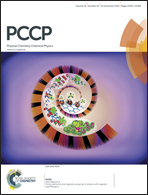Interfacial structure and orientation of confined ionic liquids on charged quartz surfaces†
Abstract
Atomistic molecular dynamics simulations have been performed to study microscopic ionic structures and orientational preferences of absorbed [BMIM] cations and four paired anions ([BF4], [PF6], [TFO] and [TF2N]) on quartz surfaces. Two chemically different quartz surface models were adopted: one is saturated with silanol Si(OH)2 groups, and the other one is covered by silane SiH2 groups, respectively. Simulation results reveal that dense ionic layers, characterized by distinct mass, number, charge and electron densities, are formed in quartz interfacial region. The orientational preferences of confined ionic groups are characterized with different features depending on the size and shape of anionic groups, and the quartz surface charge. The [BMIM] cations attach exclusively onto the negatively charged Si(OH)2 surface. The imidazolium rings lie preferentially perpendicular to Si(OH)2 surface, to which the directly connected methyl and butyl chains are oriented and elongated along Si(OH)2 surface, respectively. The anions are mainly absorbed on positively charged SiH2 surface. The main axes of asymmetric [TFO] and [TF2N] anions are perpendicular and parallel to SiH2 surface, respectively. Such distinct structural and orientational preferences of confined ionic groups attribute to the strong electrostatic interactions and the formation of hydrogen bonds between confined ionic species and quartz interfacial groups.


 Please wait while we load your content...
Please wait while we load your content...